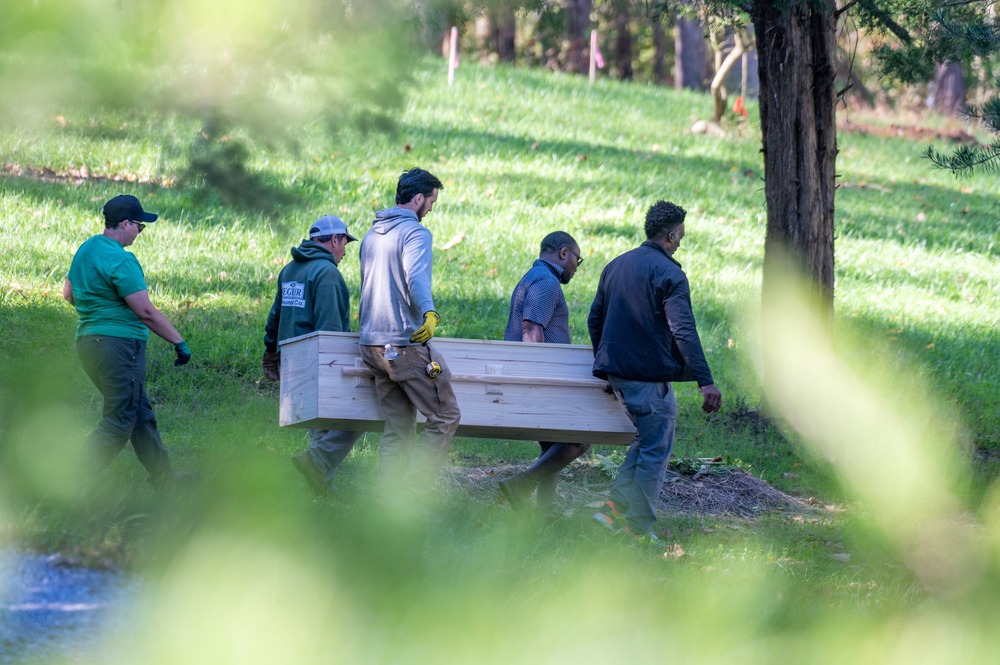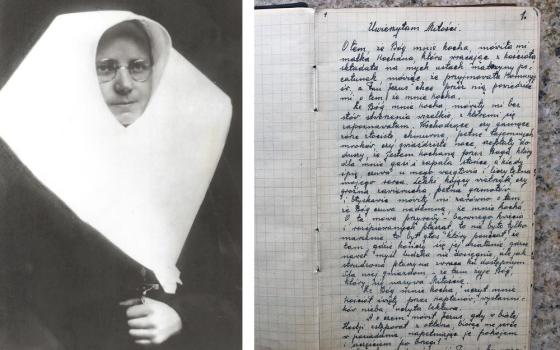
Grounds crew with Serenity Ridge Natural Burial Cemetery and Arboretum in Windsor Mill, Md., carry the deceased in a pinewood box constructed with wooden screws Oct. 9, 2024. (OSV News/ Kevin J. Parks, Catholic Review)
From the rural road in Windsor Mill, a small sign and a gravel driveway mark the entrance to Serenity Ridge Natural Burial Cemetery and Arboretum. It doesn't look much like a cemetery from the roadway, since there are no gates or raised headstones.
Located near the city of Baltimore, the cemetery had been a corn farm but had sat stagnant for three decades or more. The land has been family-owned since 1965. In 2023, the Berg brothers — Richard, David and Howard — completed five years of working with the community and local civic leaders to open Serenity Ridge as the first cemetery dedicated to only natural burials in Maryland.
Natural burial — or green burial, as it is sometimes called — is done without embalming, and uses either a biodegradable shroud only, made of cotton, linen, hemp, wool or other natural fibers, or a shroud and a biodegradable casket, made of bamboo or soft woods such as pine or bark. The caskets even include wooden screws, rather than metal.
No concrete vaults are used. Headstones placed on the grave are made from locally sourced stone. The graves are topped with soil, straw and flowers, and are replenished often over the first year as the body decomposes and the grave settles.
Melissa Baughman worked for the cemeteries for the Archdiocese of Washington for 10 years and the cemetery at Mount St. Mary's in Emmitsburg for six months before becoming cemetery manager at Serenity Ridge. She had always been an advocate for green burial and had talked about and dreamed about working at a natural cemetery, but there were none in the area.
"It's interesting because I feel that there's more respect with a natural burial," she told the Catholic Review, Baltimore's archdiocesan news outlet. "There's nothing wrong with a traditional burial," but she said she sees a greater intimacy for the family being able to be a part of the burial at Serenity Ridge, and they visit the grounds often to stop by the grave.
"All of us who work there take care of everyone who's buried there," she said. "It's very important to us."
She said when she worked at a Catholic cemetery, there were always people actively praying for the deceased, especially because priests were there often.
"As the only Catholic working here, I pray for (those interred at Serenity Ridge) every day. It's my mission to fill in that gap," said Baughman, who lives in Frederick County where she attends several different parishes.
The property at Serenity Ridge covers 100 acres, but only 45 acres has been set aside for cemetery use. The rest was given back to Baltimore County as an easement, protected forever. The cemetery allows visitors to use the area for hiking, bird-watching and other activities.
Traditional cemeteries have about 1,500 graves per acre; at Serenity Ridge, it's about 600 per acre. Currently just two areas are open in Windsor Mill: Valleys and Meadows, with rolling hills and native fields, and Inspiration Point, a wooded area closer to the forest.
Advertisement
About 85 people are interred so far, according to Chelsea Berg, community and events coordinator, who conducted a tour for prospective clients.
The cemetery staff, along with volunteers from the community, including families of those buried, work to keep the place natural by planting flowers and trees and cleaning up invasive species, she said.
Berg said families usually choose to work with a funeral home, which helps with the preparation for burial, including legal documents such as a burial transit permit. Serenity Ridge provides a list of funeral homes that can work with green burials, including the requirement that they have refrigeration, since natural burials can take place as many as 10 days after death, to provide time for family and friends to gather. Natural burials can be less expensive than traditional burials, Berg said.
Ed Morman, 77, a Baltimore City resident, took a small-group tour of Serenity Ridge on a clear fall day. He said he is considering natural burial because "it's clean. Cremation pollutes the air. I like the idea of returning to the earth," he said, though he acknowledged that cremation takes up less space than traditional burial.
A secular Jew, he said there may be a spiritual aspect to green burial. "I'd like to leave a smaller footprint," when he dies, Morman said.
Patricia McNally and her husband Andrew Kittell, both 67, of Baltimore City, also toured the property. She said they adopted a child in their late 40s and don't want her to have to deal with planning for their funerals.
McNally said their original plan was to be cremated and scattered in the mountains in New England, where they used to live, but that cremation is not environmentally friendly and it might be hard for their survivors to hike into the mountains in the winter. The non-practicing Catholics said they just changed their wills to indicate their plan for natural burial.
"We're in excellent health. We're just planning ahead, to take the burden off our daughter," McNally said.
Father Patrick Carrion, director of Cemetery Management for the Baltimore Archdiocese noted that burying without embalming has been done for centuries. Maryland law does not require a burial vault, although particular cemeteries might have that as part of their protocol.
Natural decomposition also respects the body, which in Catholic teaching is "made in the image and likeness of God and a temple of the Holy Spirit."
Having a place of burial, with a blessed grave in a Catholic committal service, "recognizes what that person was in life and respects them in death," Carrion said.





